

Shadows always point in the opposite direction of the sun and their length is a measure of the sun's (angle of) altitude above the horizon. Because it is dangerous to look directly to the sun (Attention: Danger for your eyes!) it is a good method to determine the sun's position by measuring the length and the direction of a vertical pole's shadow.
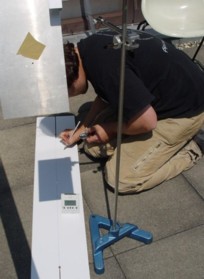 |
 |
|
|---|---|---|
| Impressions of measuring the sun's position | ||
| in Essen | and | in Isfahan |
The altitude of the sun hSun can be calculated from the ratio of the pole's and the shadow's lengths. For the measurement of the direction a reference direction is needed. Usually, the direction to south is taken for that (on the southern hemisphere: the direction to north). But, where exactly is south?
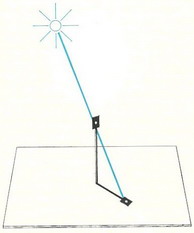
For our purpose, it is too imprecise to determine the southern direction using a compass. There are two reasons for this fact: the so called magnetic declination which is mainly caused by the difference between magnetic and geographical poles. Additionally, things made of iron influence the magnetic needle.
The exact direction to south can be determined using the pole's shadow, too: When the sun has obtained its maximum altitude it has the exact southern (northern) position. The pole's shadow will then be of shortest length and point directly north. On the southern hemisphere, the sun is then in the north and the shadow points to south. Because the shadow's length varies slowly around noon it is better to use the fact that the sun's run over the sky is precisely symmetric to its noon position and time.
Therefore, the exact southern direction can be determined by the following procedure:
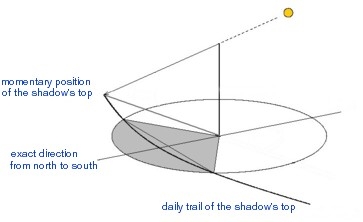
The direction from south to north is the angle bisection between two shadow's positions with equal length of the shadow!
In order to measure the sun's position precisely the position of the shadow's top has to be determined as exactly as possible. The first idea may be to use a thin and acute vertical pole. Unfortunately, the shadow will become the more blurred the smaler the pole is made!
Therefore, it is a better idea to use a small hole instead of a sharp peak. When the sun shines through small holes it causes, as in the case of a pin hole camera, round or elliptic spots of light - pictures of the sun. You can find such sun spots in nature very often, for instance under broad-leaved trees. In German, they are called "Sonnentaler" (coins made by the sun).
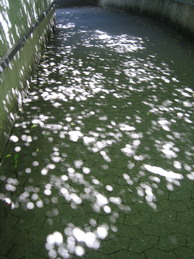
When the sun shines a roof of leaves generates a lot of round sun spots on the ground.
Because you can estimate the center of an ellipse quite well a hole at the pole's top is most suitable for our purpose. The following pictures demonstrate this fact:
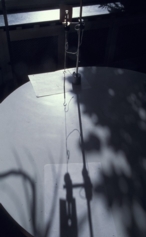 |
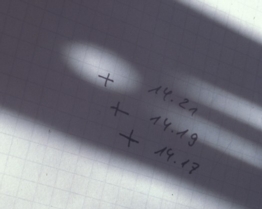 |
|
|---|---|---|
| Hole and pendulum serve as a vertical pole. |
The hole generates an elliptic picture of the sun the center of which can be determined very precisely. |
Usually, the angle aSun of the sun's direction, the so called azimuth, is measured clockwise from south. Of course, the direction of the pole's shadow may be measured from north, instead.
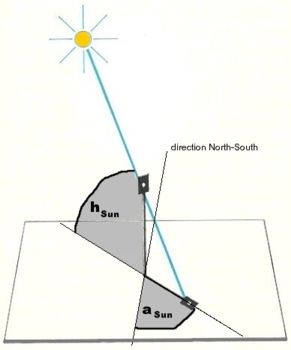
The (angle of) the sun's altitude h can be derived from the pole's height hSt and the shadow's length lSch. You may determine it pertaining to drawing
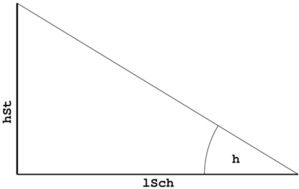
or using the following equation:

A particularly precise evaluation becomes possible drawing a coordinate system on a sheet of paper (possibly graph paper) and adjusting its y-axis to the north. Put the pole exactly onto the center and you can measure the x- and the y-coordinates of the shadow's top.
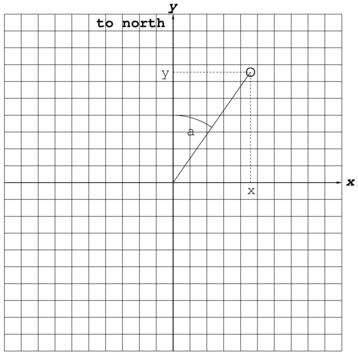
Then azimuth and altitude of the sun result from the following equations:

The procedure for deriving the own geographical position from the exact noon time and the corresponding length of the shadow is described in a document of our Venus project.
back to the project page

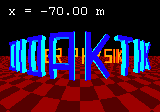
 Udo Backhaus
Udo Backhaus
